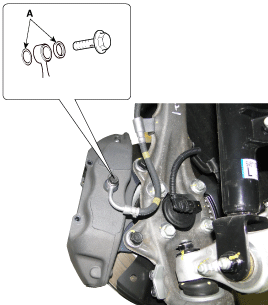Hyundai Genesis: Brake System / Brake Line Repair procedures
Hyundai Genesis (DH) 2013-2016 Service Manual / Brake System / Brake System / Brake Line Repair procedures
| Removal |
| 1. |
Disconnect the brake fluid level switch connector, and remove the reservoir cap. |
| 2. |
Remove the brake fluid from the master cylinder reservoir with a syringe. |
| 3. |
Remove the wheel & tire. |
| 4. |
Disconnect the brake hose clip (A) and then remove the brake tube by loosening the tube flare nut (B).
[Front]
[Rear]
|
| 5. |
Disconnect the brake hose from the brake caliper by loosening the bolt (A).
[Front]
[Rear]
|
| Inspection |
| 1. |
Check the brake tubes for cracks, crimps and corrosion. |
| 2. |
Check the brake hoses for cracks, damage and fluid leakage. |
| 3. |
Check the brake tube flare nuts for damage and fluid leakage. |
| 4. |
Check brake hose mounting bracket for crack or deformation. |
| Installation |
| 1. |
To install, reverse the removal procedure.
|
| 2. |
After installation, bleed the brake system.
(Refer to Brake System - "Brake System Bleeding") |
| 3. |
Check for brake fluid leaks. |
 Brake Line Components and Components Location
Brake Line Components and Components Location
Components
...
 Brake Pedal Components and Components Location
Brake Pedal Components and Components Location
Components
1. Brake pedal member assembly2. Stop lamp switch3. Clevis pin4. Snap pin5. Brake pedal stopper6. Return spring7. Bolt
...
Other information:
Hyundai Genesis (DH) 2013-2016 Service Manual: Front Strut Assembly Components and Components Location
Components [2WD] 1. Insulator cap2. Insulator assembly3. Spring upper pad4. Dust cover 5. Bump stopper6. Coil spring7. Spring lower pad8. Shock absorber [4WD] 1. Insulator cap2. Insulator assembly3. Spring upper pad4. Dust cover 5. Bump stopper6. Coil spring7. Spring lower pad8. Sho ...
Hyundai Genesis (DH) 2013-2016 Service Manual: Side Airbag (SAB) Module Description and Operation
Description The Side Airbags (SAB) are installed inside the front seat and protects the driver and passenger from danger when a side crash occurs. The SRSCM determines deployment of the side airbag by using the Side Impact Sensor (SIS) signal. Never attempt to measure ...
© 2013-2025 www.hgenesisdh.com






